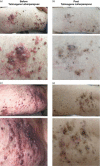Potential clinical and immunotherapeutic utility of talimogene laherparepvec for patients with melanoma after disease progression on immune checkpoint inhibitors and BRAF inhibitors
- PMID: 29561296
- PMCID: PMC5929488
- DOI: 10.1097/CMR.0000000000000444
Potential clinical and immunotherapeutic utility of talimogene laherparepvec for patients with melanoma after disease progression on immune checkpoint inhibitors and BRAF inhibitors
Abstract
Talimogene laherparepvec is a genetically modified herpes simplex virus type 1-based oncolytic immunotherapy for the local treatment of unresectable subcutaneous and nodal tumors in patients with melanoma recurrent after initial surgery. We report on two patients with melanoma who, after progression on numerous systemic therapies, derived clinical benefit from talimogene laherparepvec in an expanded-access protocol (ClinicalTrials.gov, NCT02147951). Intralesional talimogene laherparepvec (day 1, ≤4 ml 10 PFU/ml; after 3 weeks, ≤4 ml 10 PFU/ml every 2 weeks) was administered until complete response, no injectable tumors, progressive disease, or intolerance occurred. Patient 1 was 71 years old, had stage IIIB disease, and had previously received granulocyte-macrophage colony-stimulating factor, vemurafenib, metformin, ipilimumab, dabrafenib, trametinib, and pembrolizumab. Patient 2 was 45 years old, had stage IIIC disease, and had previously received nivolumab/ipilimumab combination therapy. There were marked reductions in the number and size of melanoma lesions during treatment with talimogene laherparepvec. Both patients experienced mild-to-moderate nausea and vomiting, which were managed using ondansetron, metoclopramide, and pantoprazole. Both patients completed treatment with talimogene laherparepvec in the expanded-access protocol on 24 November 2015, but received talimogene laherparepvec in clinical practice. Patient 1 continues to receive therapy (>60 weeks); patient 2 experienced a complete response at 23 weeks. Immunohistochemistry of a biopsied dermal metastasis from patient 1 showed a marked infiltration of CD4 and CD8 T cells after 1 year of treatment. Talimogene laherparepvec was active in patients with advanced melanoma with disease progression following multiple previous systemic therapies; no new safety signals were identified.
Figures


References
-
- Hauschild A, Grob JJ, Demidov LV, Jouary T, Gutzmer R, Millward M, et al. Dabrafenib in BRAF-mutated metastatic melanoma: a multicentre, open-label, phase 3 randomised controlled trial. Lancet 2012; 380:358–365. - PubMed
-
- Long GV, Stroyakovskiy D, Gogas H, Levchenko E, de Braud F, Larkin J, et al. Dabrafenib and trametinib versus dabrafenib and placebo for Val600 BRAF-mutant melanoma: a multicentre, double-blind, phase 3 randomised controlled trial. Lancet 2015; 386:444–451. - PubMed
-
- Larkin J, Ascierto PA, Dreno B, Atkinson V, Liszkay G, Maio M, et al. Combined vemurafenib and cobimetinib in BRAF-mutated melanoma. N Engl J Med 2014; 371:1867–1876. - PubMed
Publication types
MeSH terms
Substances
Associated data
LinkOut - more resources
Full Text Sources
Other Literature Sources
Medical
Research Materials

